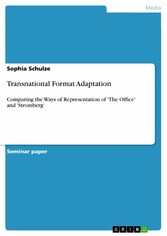Suchen und Finden
Transnational Format Adaptation - Comparing the Ways of Representation of 'The Office' and 'Stromberg'
Mehr zum Inhalt

Transnational Format Adaptation - Comparing the Ways of Representation of 'The Office' and 'Stromberg'
Seminar paper from the year 2012 in the subject Communications - Movies and Television, grade: 1,7, University of Bremen (Institut für historische Publizistik, Kommunikations- und Medienwissenschaft), course: Transcultural Communication, language: English, abstract: Everyone who is familiar with the current television landscape can probably name at least one or two TV programs of which they know there are other versions of the same programs broadcasted in other regions of the world. To name only a few, there are quiz and game shows, such as Who Wants to Be a Millionare? or Wheel of Fortune, reality shows, such as Big Brother or The Bachelor, but also drama programs, such as Coronation Street or The Restless Years. Different versions of the same program often show striking similarities in their basic structure, they might have similar narratives and characters, or even convey the same values; yet they have a local coloring from the region where they are produced through local participants or actors, plotlines based on local problems or local cultural references. This is caused by the fact that the different versions of one program stem from the same format that originated in one cultural environment, was taken over into other regions and adapted to the local backgrounds. This process of deterritoralizing TV formats by using a foreign format and producing a local version of it is called transnational TV format adaptation. The reason why there is an increase in transnational format adaptations and why consumers are aware of that is because of the continuing globalization of media communication, meaning the advanced exchange of products, practices and ideas through progressive technology (Hepp 2006: 9f.). While being a result of globalization, however, format adaptations are produced in local contexts 'integrating 'local' content in various ways' (Machin/Leeuwen 2007: 1f.). By combining parts of different cultures they are neither completely global nor local products but rather examples a transnational media landscape (cf. Jensen 2007: 5, 13). Although 'the prac-tice is not new and can be traced back to the radio', research focused more on transnational program sales or co-productions, and format adaptation has only come to the center of atten-tion in research in the past 15 years (see Moran 1998, Moran/Malbon 2006, Jensen 2007).This is why this topic has aroused my interest and will be the topic of this paper.
Alle Preise verstehen sich inklusive der gesetzlichen MwSt.







